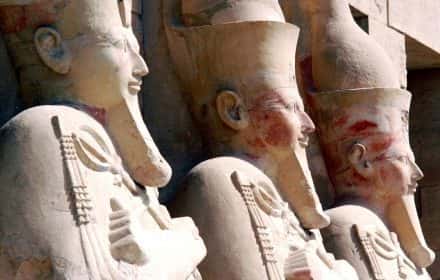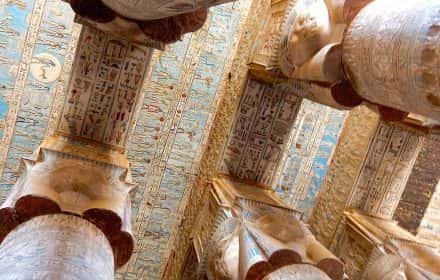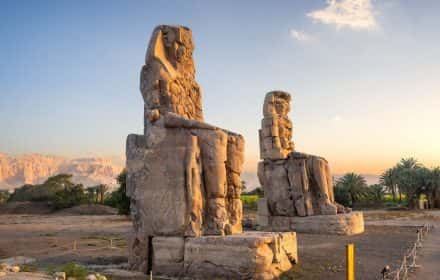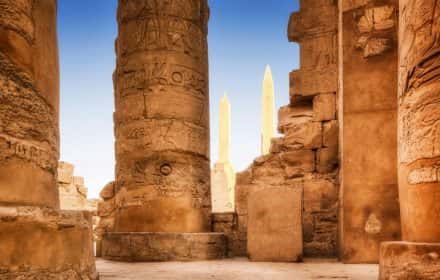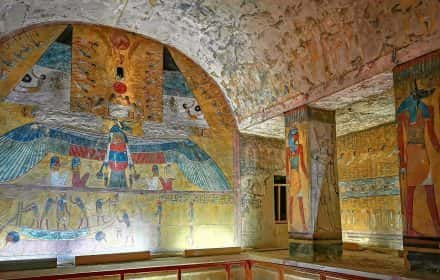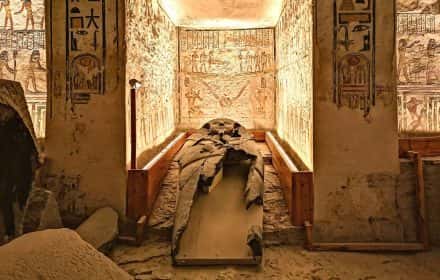This site uses affiliate links, meaning that if you make a purchase through our links, we may earn an affiliate commission.
Step into a world where the past lives on – Luxor Temple, an ageless wonder nestled along the Nile’s edge.
Join us as we unlock its secrets, revealing what to see at Luxor Temple – 11 must-see spectacles that capture the essence of ancient Egypt’s grandeur. From towering statues that stand sentinel to intricate hieroglyphs mapping stories of old, Luxor Temple beckons.
Let’s embark on this journey, a virtual odyssey into the heart of a timeless icon!
Luxor Temple
- 1. What You Need to Know About Luxor Temple (Luxor Temple Facts)
- 2. What to See at Luxor Temple - 11 Things You Can't Miss
-
- 2.1. The Avenue of the Sphinxes
- 2.2. The First Pylon
- 2.3. The Obelisk
- 2.4. The Colossal Statues of Ramses II
- 2.5. The Courtyard of Ramses II
- 2.6. The Mosque of Abu Haggag
- 2.7. The Processional Colonnade of Amenhotep III
- 2.8. The Courtyard of Amenhotep III
- 2.9. The Hypostyle Hall of Amenhotep III
- 2.10. The Central Chamber
- 2.11. The Birth Chamber of Amenhotep III
- 3. Intrepid Scout's Tips for Visiting Luxor Temple
What You Need to Know About Luxor Temple (Luxor Temple Facts)
- In the Footsteps of Great Builders
The construction of the Luxor Temple was started by one of the great builders of ancient Egypt, Pharaoh Amenhotep III.
Another incredible project of Amenhotep III was the largest mortuary temple ever erected in Egypt and situated on the West Bank of the River Nile in Luxor. Today, what is left of this magnificent construction are two giant statues known as the Colossi of Memnon.
- A Tapestry of Pharaonic Contributions
Tutankhamun, Horemheb, Merenpetah, Seti I, Ramses III, Ramses IV, Ramses VI, and even Alexander the Great incorporated many small additions to the Temple of Luxor. However, the major expansion effort took place during the reign of another great builder of ancient Egypt, Ramses II.
- Hailing Gods
The temple was dedicated to Amon, king of the gods, his consort Mut, and their son Khons.
- Hidden Beneath Time,
Gradually, through centuries, Luxor Temple got buried underneath silt from the River Nile. Sand, rubble, and trash accumulated on top of it to the extent that the Mosque of Abu Hggag was built on top of the temple in the 13th century AD.
- Resurrecting the Past
The excavation of the Luxor Temple was started in 1884 by Professor Gaston Maspero. The excavations were carried out sporadically until 1960.
What to See at Luxor Temple - 11 Things You Can't Miss
The Avenue of the Sphinxes
The front of the Luxor Temple has an impressive avenue, which once stretched all the way to the Karnak Temple. The avenue is decorated by two rows of human-headed sphinxes.
The Avenue of the Sphinxes was known as the Sacred Way. It was added by the Pharaoh Nectanebo I.
Did you know that the Avenue of the Sphinxes was used once a year during the Opet Festival?
The Beautiful Feast of Opet (or Opet Festival) was an Ancient Egyptian festival celebrated annually in Thebes (Luxor), during the New Kingdom and in later periods.
The statues of the deities of the Theban Triad — Amun, Mut, and their child Khonsu — were escorted in a joyous procession, though hidden from sight in a sacred bark, from the temple of Amun in Karnak to the temple of Luxor, a journey of more than 1 mile (2 km), in a marital celebration.
The highlight of the ritual was the meeting of Amun-Re of Karnak with the Amun of Luxor. Rebirth was a strong theme of Opet and there was usually a re-coronation ceremony of the pharaoh.
Source: Wikipedia
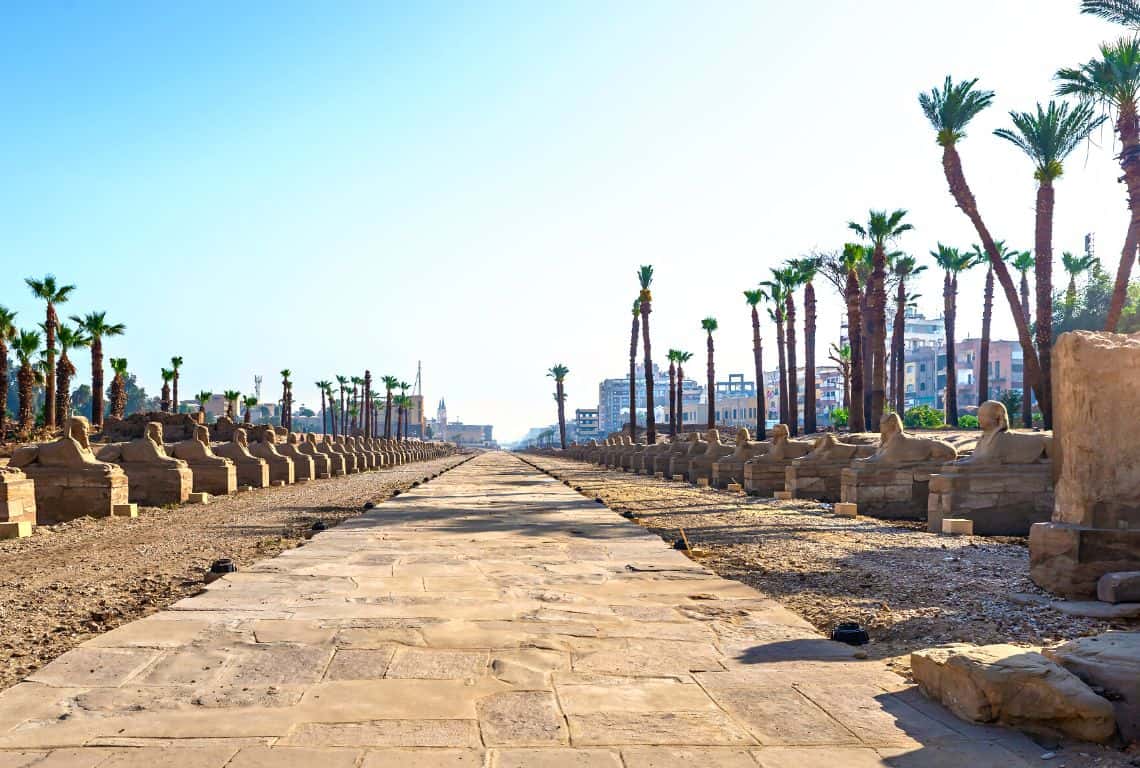
The Avenue of the Sphinxes / What to See at Luxor Temple
The First Pylon
The First Pylon, also known as the front entrance or gateway, serves as the monumental entrance to Luxor Temple. It is a massive stone structure that stands as a testament to ancient Egyptian architecture and the grandeur of the temple complex.
Built by Ramses II, the First Pylon is the largest of the pylons at Luxor Temple standing at 70 feet high. It is richly decorated with intricate carvings and reliefs that depict scenes of royal rituals, triumphs in the Battle of Kadesh, and religious ceremonies.
You can see four openings in the First Pylon. These openings helped to support the flag masts with banners.
The First Pylon is flanked by massive statues of seated pharaohs. These statues, often called colossi, were designed to depict the rulers in their divine and authoritative roles. The statues and the towers together create an imposing and awe-inspiring sight that greets visitors as they enter the temple.
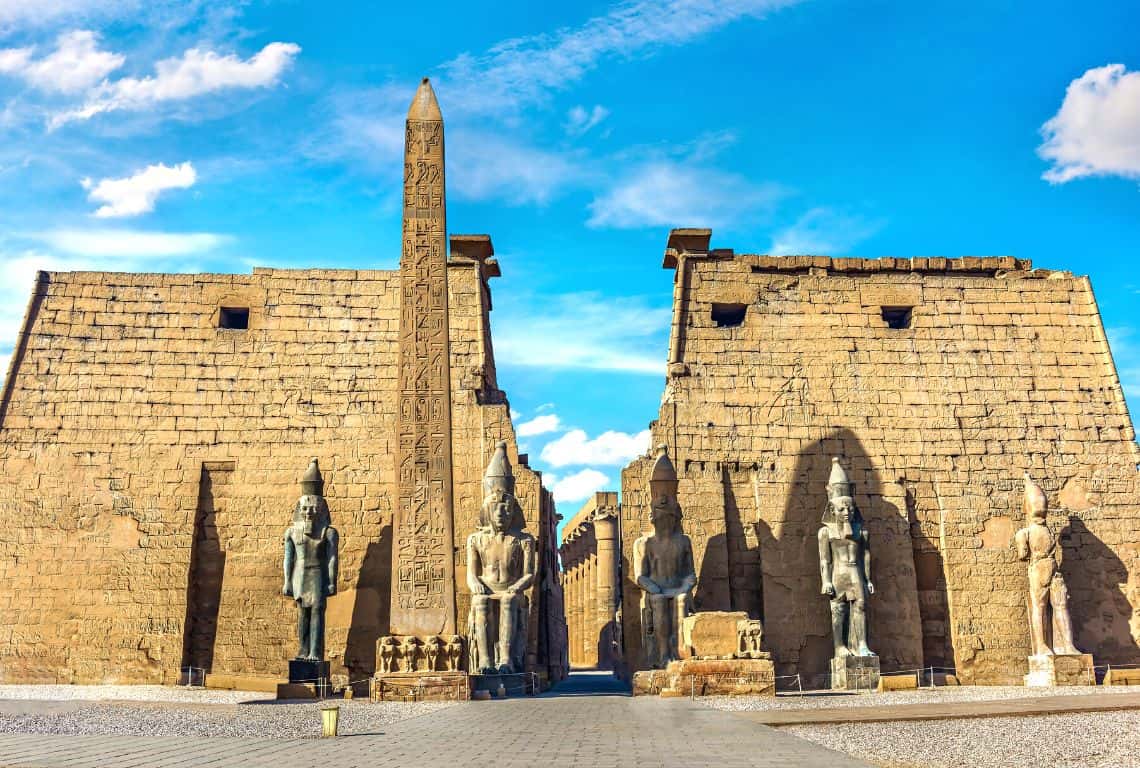
The First Pylon / What to See at Luxor Temple
The Obelisk
The obelisk at Luxor Temple stands as a solitary sentinel, a monolithic structure that reaches towards the sky, symbolizing the connection between the earthly realm and the heavens above. This remarkable obelisk, though now a single sentinel, was once part of a pair, with its twin standing in symmetry at the temple’s entrance.
In ancient Egyptian culture, obelisks were laden with symbolism. They represented the “benben,” the primordial mound upon which the god Atum stood to create the world. Thus, obelisks were seen as powerful conduits of divine energy, bridging the gap between mortal and immortal realms.
The obelisk at Luxor Temple is adorned with intricate hieroglyphic inscriptions. These inscriptions serve as a record of the pharaoh’s achievements, divine connections, and religious dedications. They offer a window into the cultural, religious, and historical beliefs of ancient Egypt, immortalizing the pharaoh’s reign and accomplishments.
Obelisks were hewn from a single piece of stone, usually granite. Their construction involved immense skill and effort, reflecting the technological prowess of ancient Egyptian artisans. The obelisk at Luxor Temple was quarried and shaped, then transported to its designated spot within the temple complex.
Originally, the obelisk at Luxor Temple was part of a pair that adorned the entrance of the temple. Its twin now stands far away, known as the Obelisk of Luxor, prominently displayed at the center of the Place de la Concorde in Paris, France. This separation is a testament to the global fascination with Egyptian antiquities.
The obelisk was a gift of Muhamed Ali to King Philip Louis of France. The obelisk first arrived in Paris on 21 December 1833 and three years later, on 25 October 1836, it was moved to the center of Place de la Concorde.
The French gifted a clock to the Egyptians. It is situated at the Cairo Citadel. Sadly, it has never worked.
The Colossal Statues of Ramses II
The colossal statues of Ramses II stand proudly at the entrance of Luxor Temple, exuding an aura of majesty and authority. Carved from massive blocks of stone, these statues are not only a testament to Ramses II’s reign but also a symbol of his enduring legacy.
The statues of Ramses II were strategically placed to guard the entrance of the temple, serving as protectors and sentinels. Their colossal size was intended to emphasize the pharaoh’s might and authority, showcasing his dominion over both the physical and spiritual realms.
The statues depict Ramses II in the traditional regal attire of ancient Egyptian pharaohs. He is shown wearing the double crown of Upper and Lower Egypt, symbolizing his rule over the entire kingdom.
The statues’ detailed facial features and the intricate carvings on his royal garments provide insights into the aesthetics and artistic craftsmanship of the time.
The Courtyard of Ramses II
Nestled within the heart of Luxor Temple, the Courtyard of Ramses II stands as a timeless testament to the grandeur and significance of ancient Egyptian architecture. This open expanse, flanked by towering columns and surrounded by intricately adorned walls, beckons visitors to step into the very essence of an epoch long past.
The Courtyard of Ramses II is a carefully designed space that showcases the harmony between art and architecture in ancient Egypt. This sacred courtyard served as a central hub for ceremonies, rituals, and gatherings, making it a focal point of religious and cultural life.
The courtyard’s most distinctive features are the grand columns that encircle it. These colossal columns, designed with meticulous attention to detail, stand as a forest of stone giants, their imposing presence reflecting the strength and might of the pharaohs.
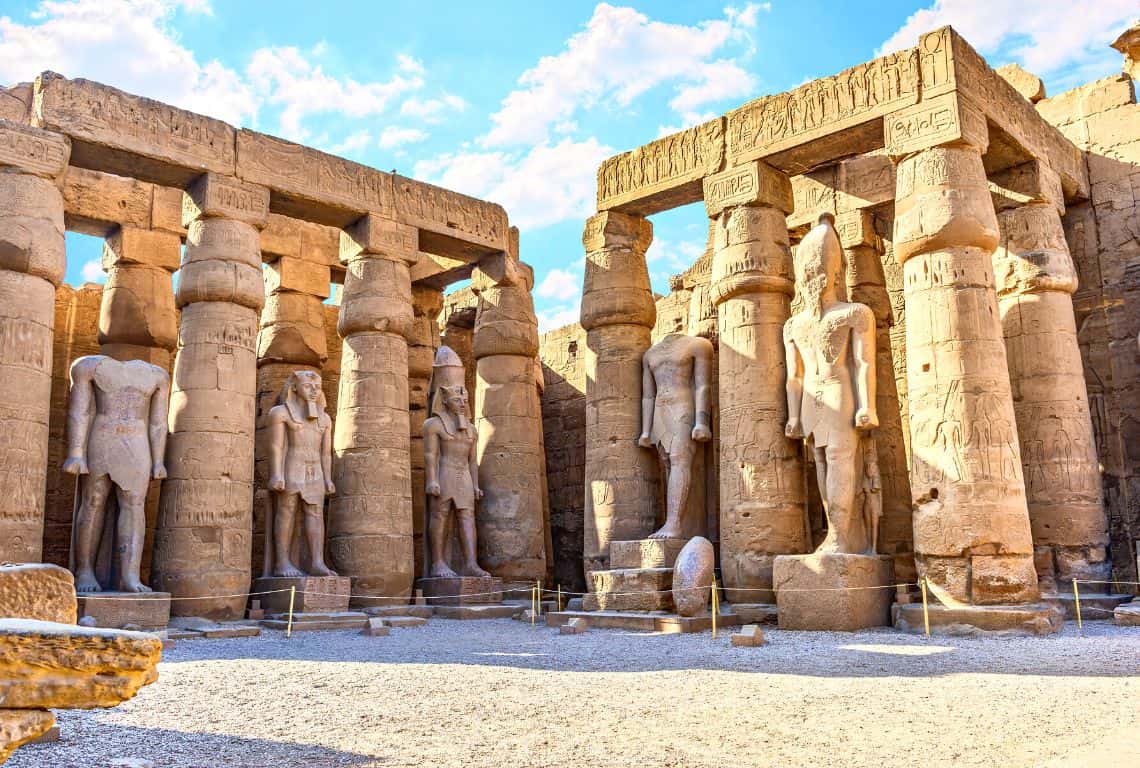
The Courtyard of Ramses II / What to See at Luxor Temple
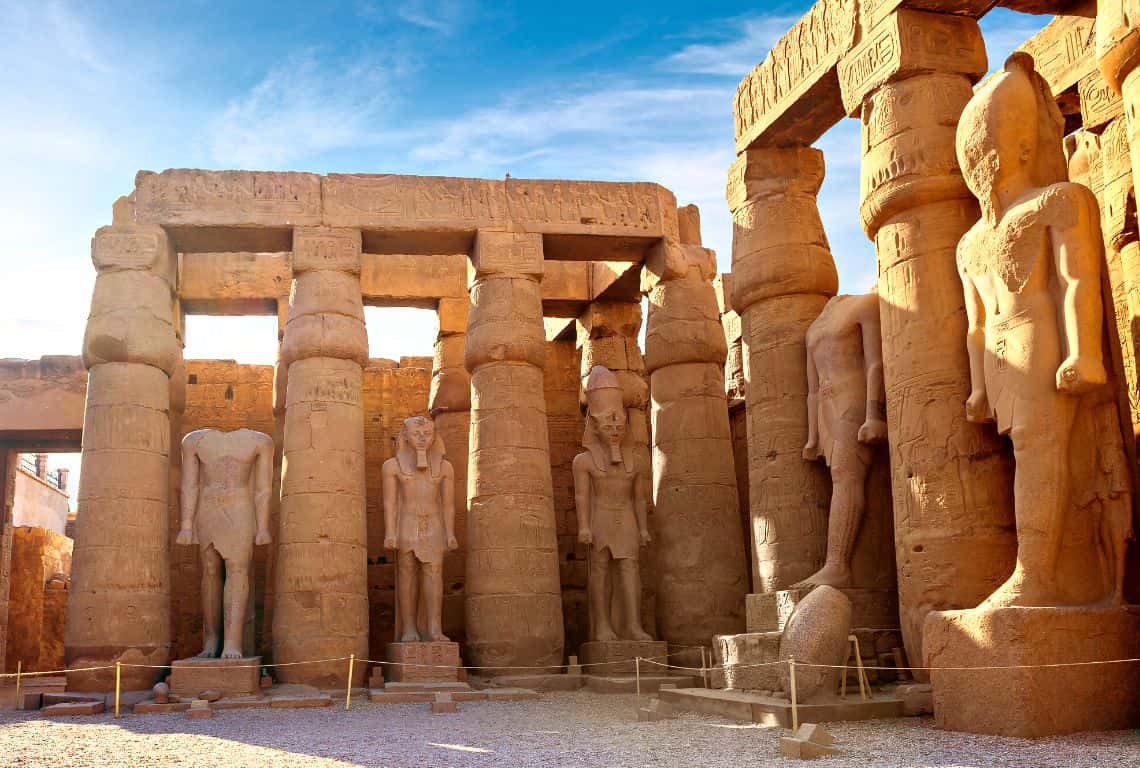
The Courtyard of Ramses II / What to See at Luxor Temple
The Mosque of Abu Haggag
As you stand in the awe-inspiring Courtyard of Ramses II within Luxor Temple, make sure to look up to your left. You will be able to see the Mosque of Abu Haggag, basically sitting on top of the colonnades of the Courtyard of Ramses II.
By the time of the Arab conquest and the ensuing centuries, Luxor Temple had faced the gradual accumulation of river silt, a natural phenomenon that submerged the splendor beneath layers of earth. As a result, the Mosque of Abu Haggag was erected on the temple’s very foundations.
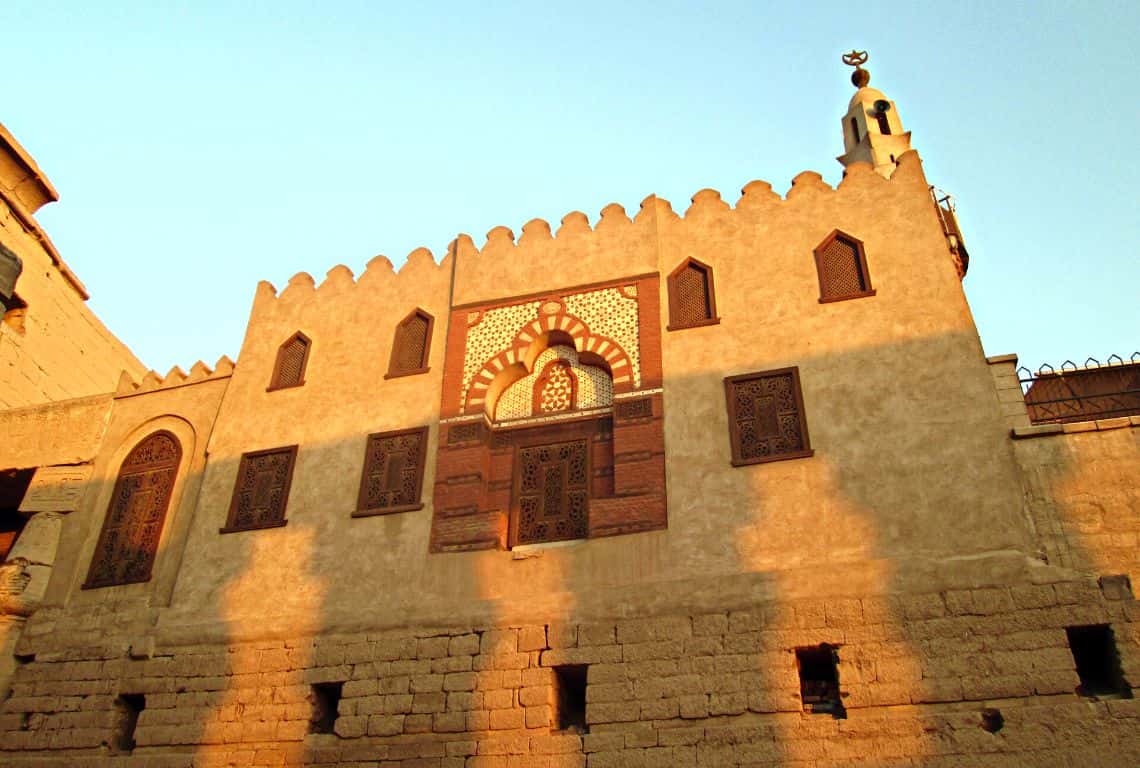
The Mosque of Abu Haggag / What to See at Luxor Temple
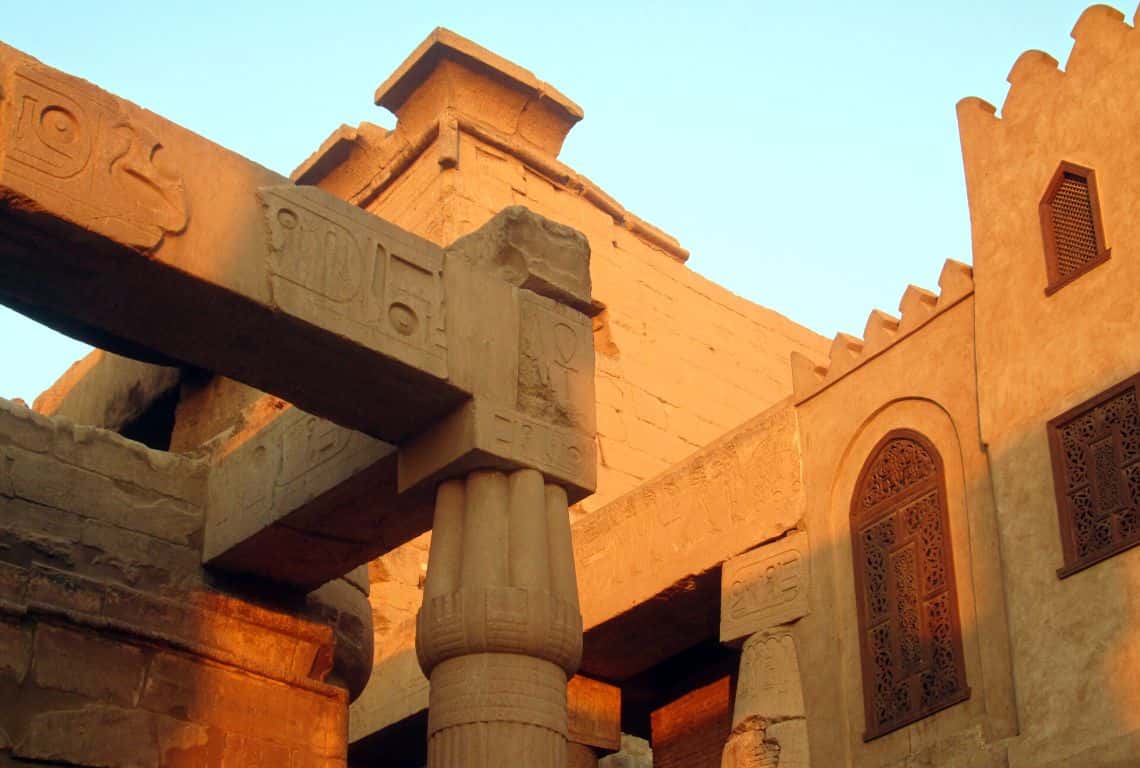
The Mosque of Abu Haggag / What to See at Luxor Temple
The Processional Colonnade of Amenhotep III
After the amazing Courtyard of Ramses II comes the Processional Colonnade of Amenhotep III.
The Processional Colonnade of Amenhotep III is a monumental pathway within Luxor Temple, consisting of 14 massive columns adorned with hieroglyphics and carvings. Constructed during the reign of Amenhotep III, the avenue served as a ceremonial thoroughfare for religious processions, connecting the temple’s entrance to its inner sanctums.
Each column, standing around 16 meters tall, features intricate depictions of pharaohs in ceremonial attire, highlighting the link between divinity and earthly rule. This avenue once witnessed the grandeur of ancient rituals and continues to stand as a testament to the architectural prowess and cultural significance of ancient Egypt.
Although it was built by Amenhotep III, Tutankhamun, Horemheb, Seti I, Ramses II, and Seti II all recorded their names on these magnificent columns.
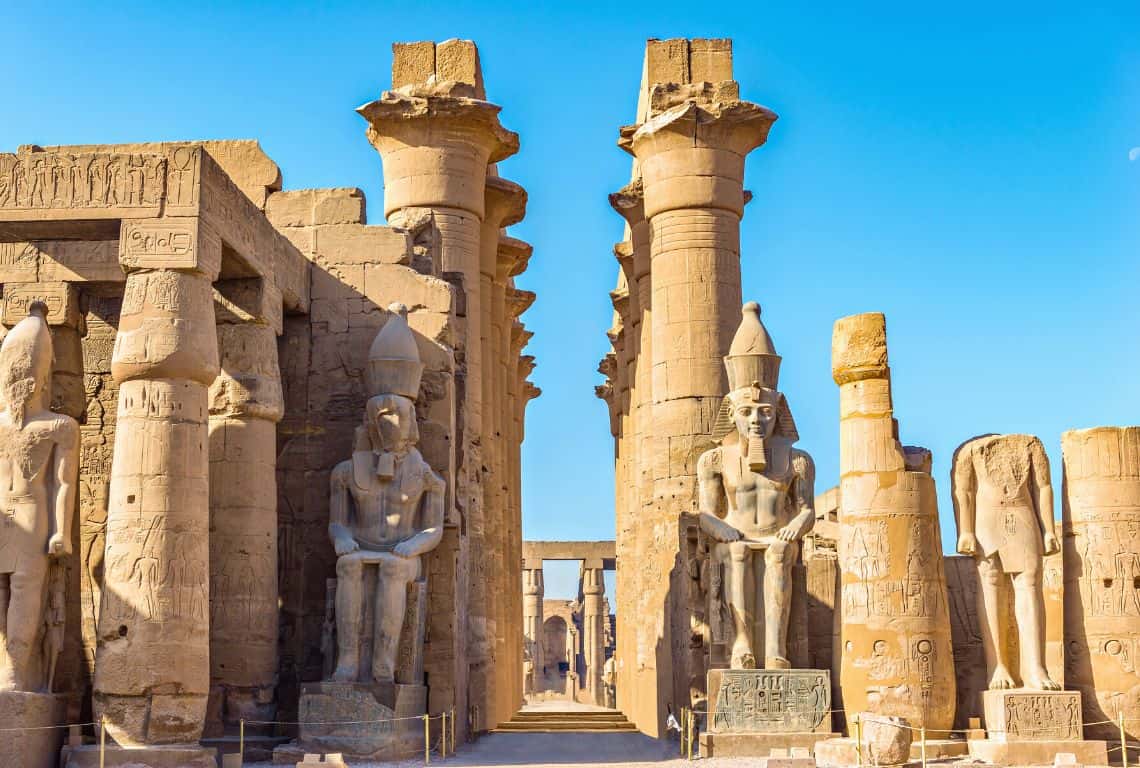
The Processional Colonnade of Amenhotep III / What to See at Luxor Temple
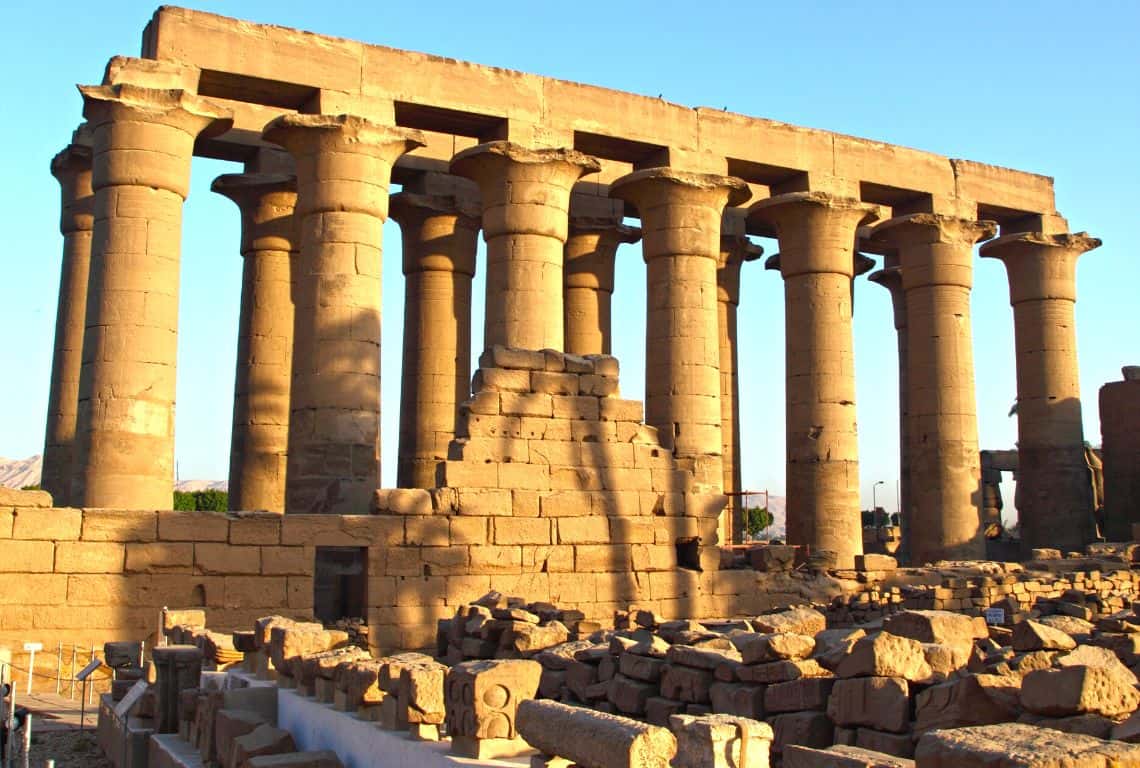
The Processional Colonnade of Amenhotep III / What to See at Luxor Temple
The Courtyard of Amenhotep III
The Courtyard of Amenhotep III is a captivating open space nestled within Luxor Temple, known for its symmetrical layout and intricate architectural details.
Flanked by grand colonnades and towering walls adorned with carvings and hieroglyphics, the courtyard exudes a sense of grandeur and reverence.
It was originally created by Pharaoh Amenhotep III as part of his expansion of the temple complex, and it served as a central gathering place for religious ceremonies and festivities.
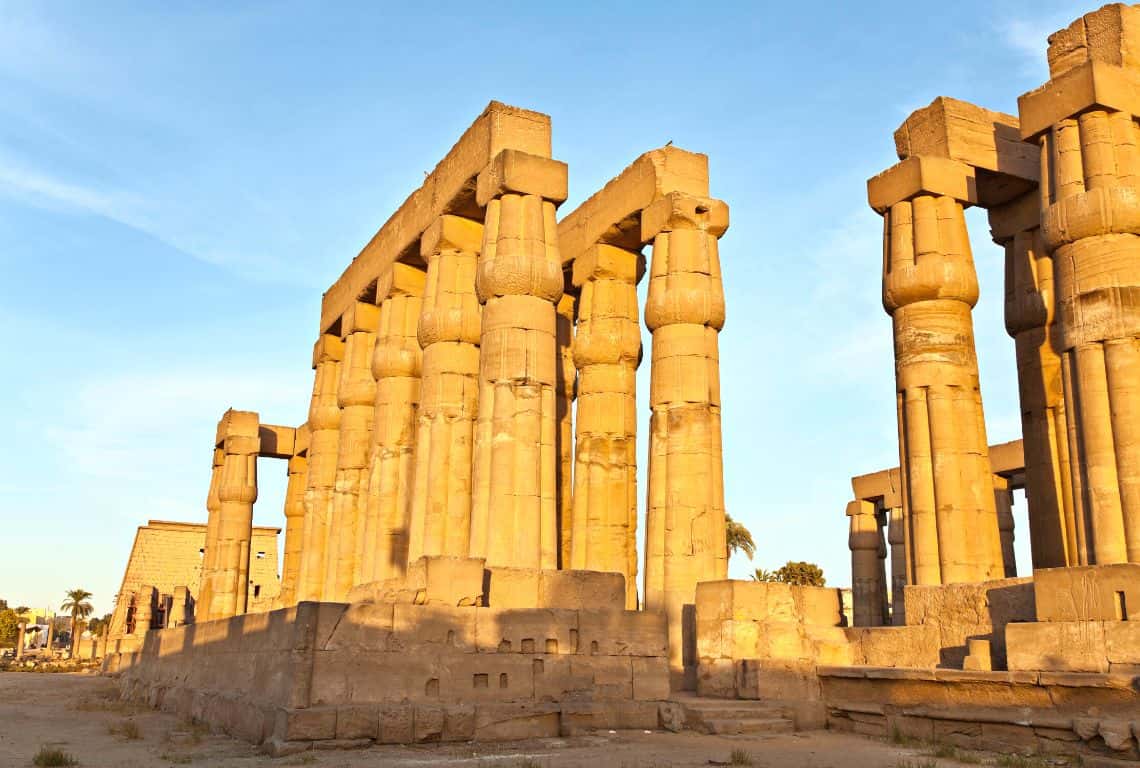
The Courtyard of Amenhotep III / What to See at Luxor Temple
The Hypostyle Hall of Amenhotep III
The Hypostyle Hall of Amenhotep III is an awe-inspiring architectural masterpiece located within Luxor Temple. This hall stands as a testament to ancient Egyptian ingenuity, boasting a mesmerizing array of colossal columns that create a forest-like effect.
Constructed during the reign of Pharaoh Amenhotep III, the hall served as a monumental assembly and ceremonial space.
Comprising a staggering 32 columns, the Hypostyle Hall is a symphony of stone that showcases the precision of ancient engineering. The hall’s columns are meticulously carved with intricate hieroglyphics and depictions of deities and pharaohs, narrating tales of divine interactions and significant events.
The Hypostyle Hall’s grandeur is not solely in its scale; it’s also in its atmospheric qualities. As sunlight filters through the columns, casting ever-changing patterns of light and shadow, visitors are transported into a realm where time seems to stand still. The acoustics of the hall amplify even the faintest sounds, allowing one to imagine the whispers of ceremonies and the hushed footsteps of ancient worshipers.
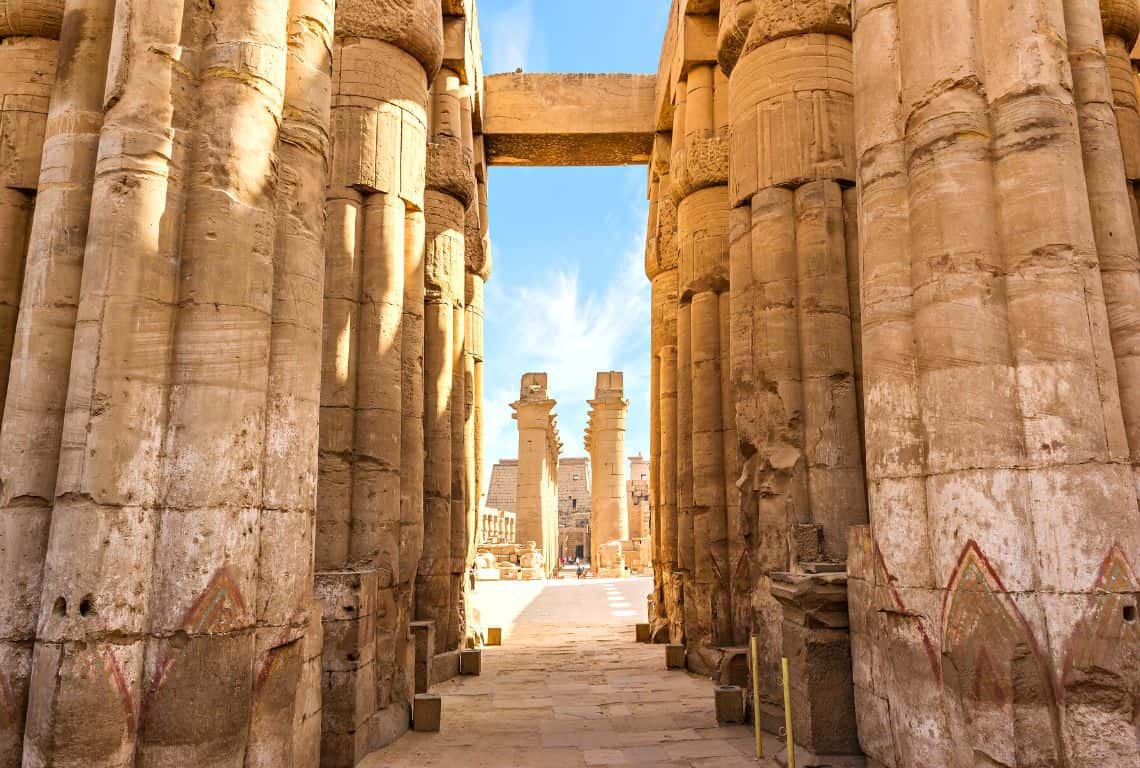
The Hypostyle Hall of Amenhotep III / What to See at Luxor Temple
The Central Chamber
The Hypostyle Hall opens to the Central Chamber. It was stuccoed and painted over by the Romans in the 3rd century AD. The paintings are still vividly visible.
Once you pass through the Central Chamber, you will reach chapels dedicated to Mut and Khonsu. And, finally, you will get to an amazing Amenhotep III’s Birth Chamber.
The Birth Chamber of Amenhotep III
The Birth Chamber of Amenhotep III is a remarkable chamber within Luxor Temple that carries profound symbolism related to the divine lineage of pharaohs.
This chamber also referred to as the “Mammisi,” served as a sacred space where rituals and ceremonies associated with the divine birth and coronation of pharaohs took place.
The term “Mammisi” is derived from the Coptic word “ma mmisi,” meaning “birthplace.” In ancient Egyptian mythology, pharaohs were believed to be descendants of gods, and their births were seen as divine events. The Birth Chamber, with its architectural splendor and intricate carvings, was designed to celebrate the divine birth of the ruling pharaoh and to reinforce the ruler’s connection with deities.
The Birth Chamber’s design is a nod to the concept of “maat,” the ancient Egyptian principle of cosmic order and balance. Its alignment and layout reflect the Egyptian understanding of harmony in architecture and its connection to cosmic harmony.
The chamber’s location within the temple complex also highlights its pivotal role in the pharaoh’s journey from divine birth to rightful rule.
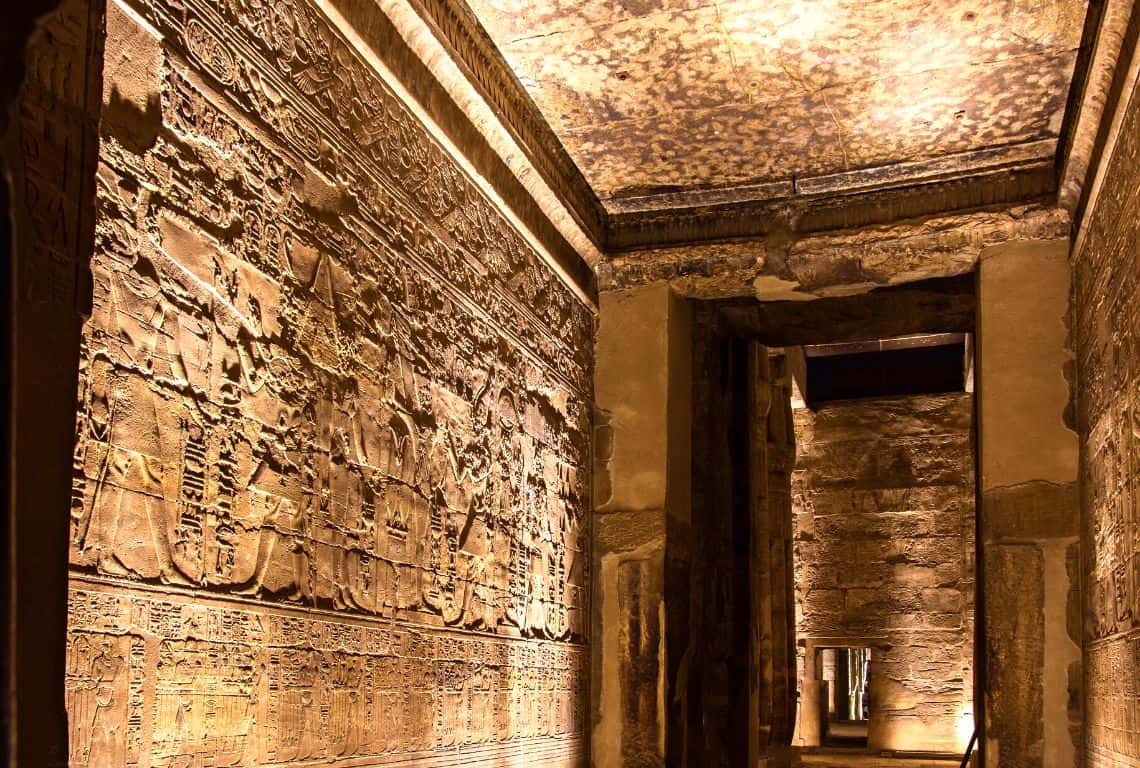
The Birth Chamber / What to See at Luxor Temple
Intrepid Scout's Tips for Visiting Luxor Temple
- Luxor Temple is open daily from 6 am to 10 pm. However, the best time to visit the temple is before 8 am. You will practically have the entire place to yourself and be able to get some awesome photos without any people in them. The tourist buses start arriving at around 9-10 am and the place gets very crowded.
- Make sure to circle back to the temple in the evening to see it beautifully illuminated.
- The best way to get to Luxor Temple is by having a driver and a tour guide. This option gives you total flexibility. You can decide how much time you need to see everything at the Luxor Temple. Plus, having a knowledgeable guide by your side is absolutely priceless! If you are staying in one of the hotels in Luxor, your hotel will be more than happy to arrange for you a driver and a guide. Needless to say, this is an expensive option, but it is all worth it. Another option is to just book a taxi and head to the Luxor Temple. You will always be able to hire a guide right at the entrance to the Luxor Temple.
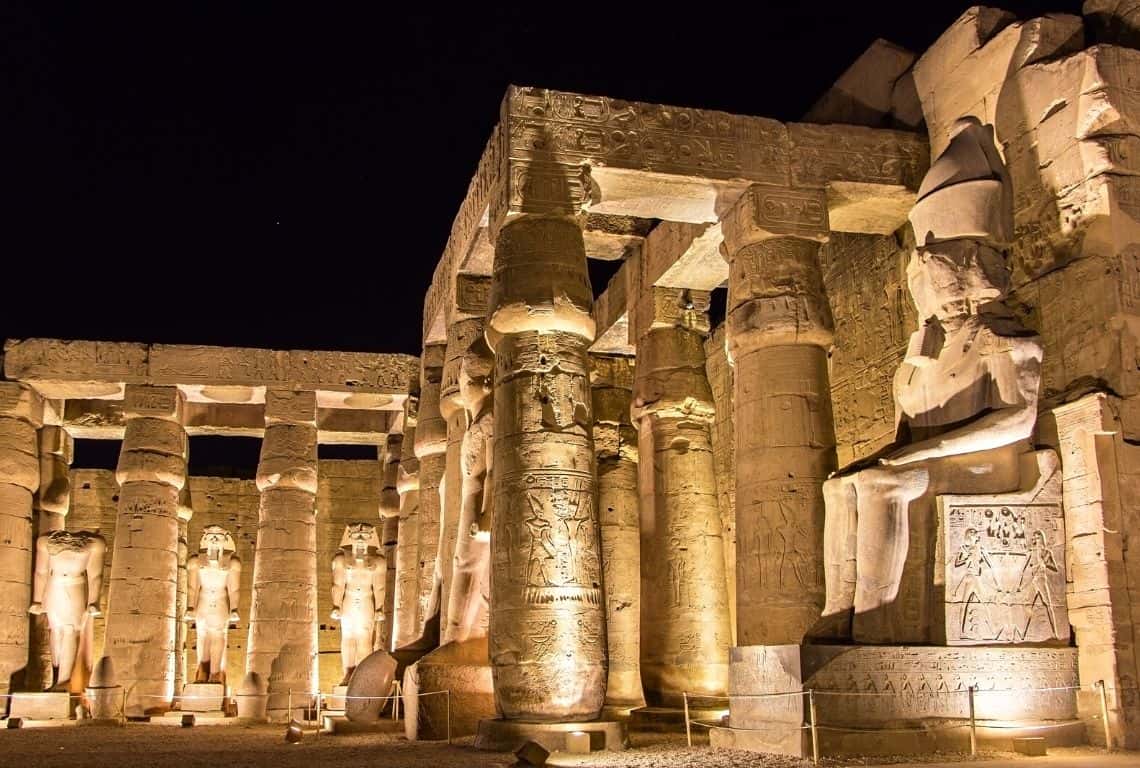
Luxor Temple at Night / What to See at Luxor Temple
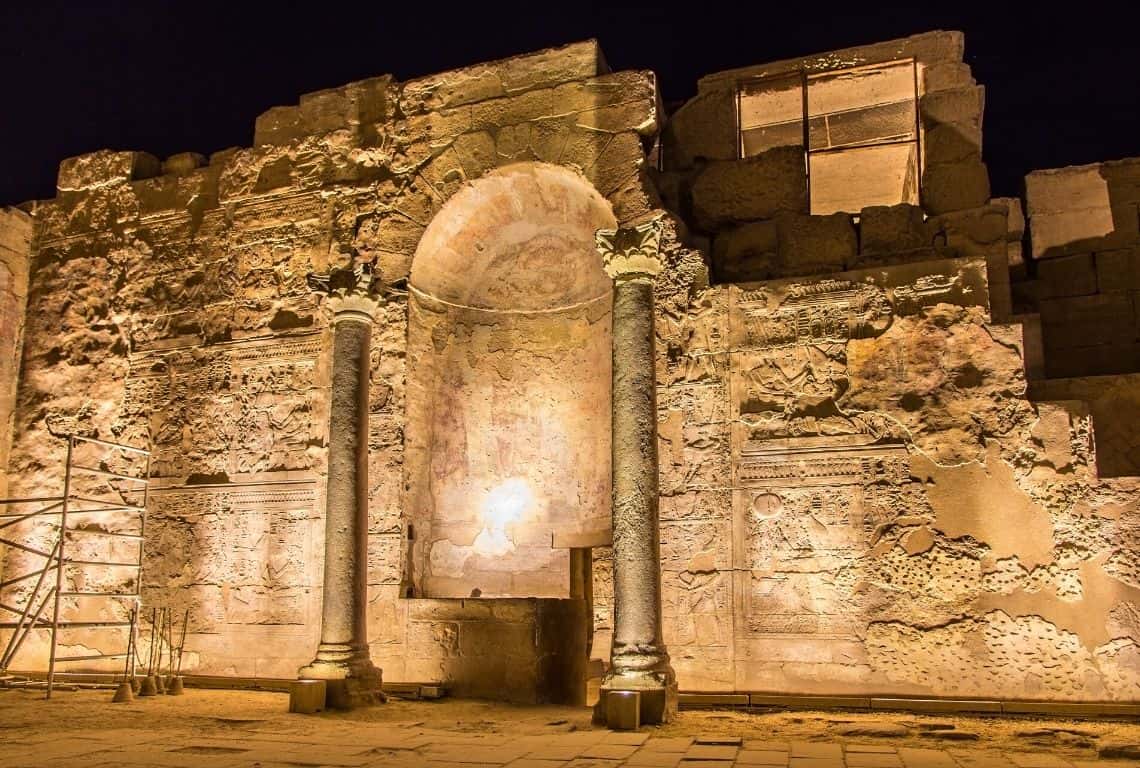
Luxor Temple at night / What to See at Luxor Temple
You Might Also Like
10 Epic Things to See and Do at the Pyramids of Giza
12 Important TIPS for First VISIT to VALLEY of the KINGS in Luxor
12 Important TIPS for Hot AIR BALLOON RIDE in LUXOR, Egypt (Read Before You Book It)
Perfect 2-Day Itinerary in Luxor (7 Things You Can’t Miss)
14 EGYPT TIPS for FIRST TIMERS (How to Save Time, Money, and Be Safe)
How to Visit And What to See at ABU SIMBEL (9 Practical Things to Know)
How to Visit KARNAK TEMPLE in Luxor (9 Amazing Things You Can’t Miss)
19 Must-See Things at Egyptian Museum in Cairo (+Practical Tips)
Why You Should Visit Horus Temple of Edfu in Egypt
Did You Find This Useful?
Why Not Save What to See at Luxor Temple to Your Pinterest Board!
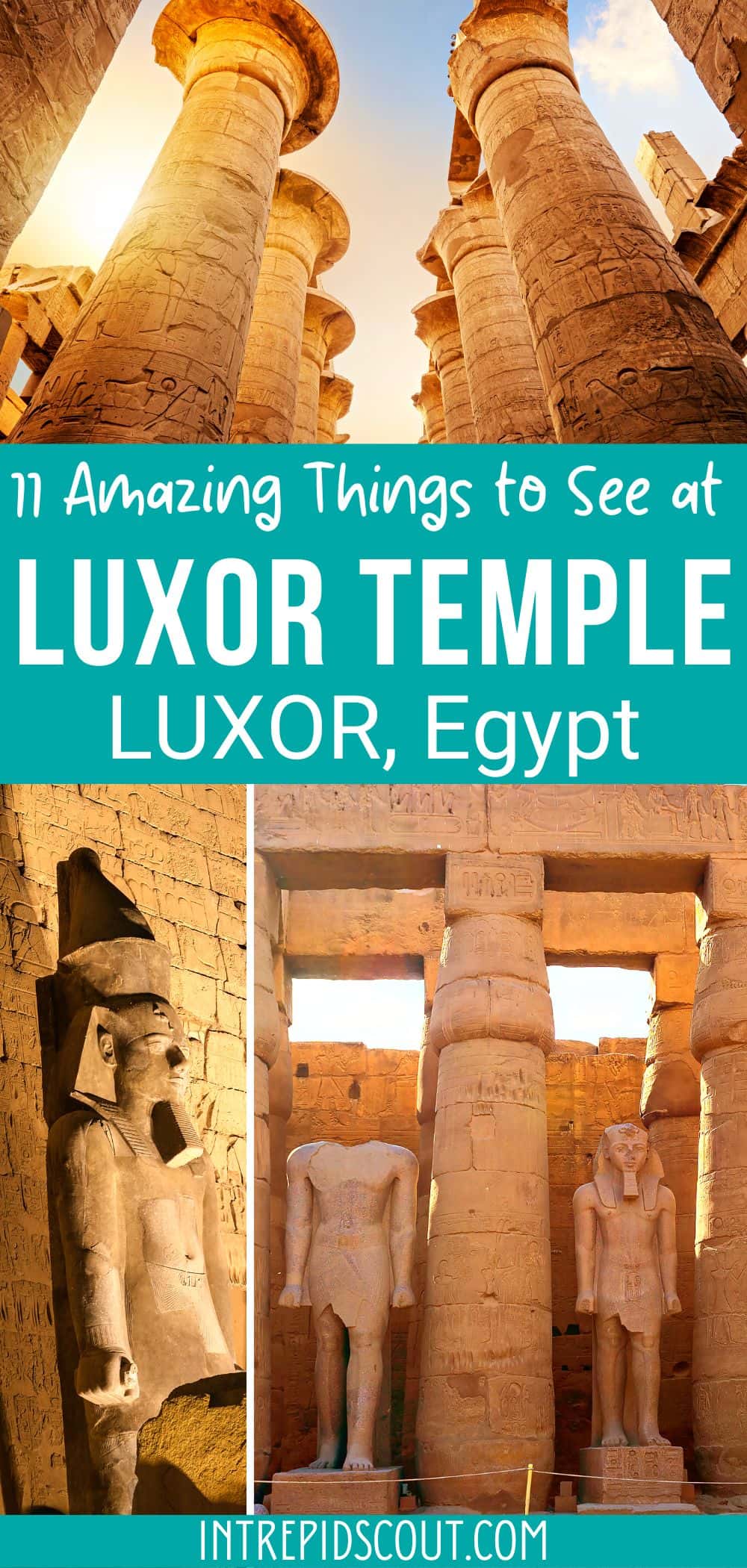
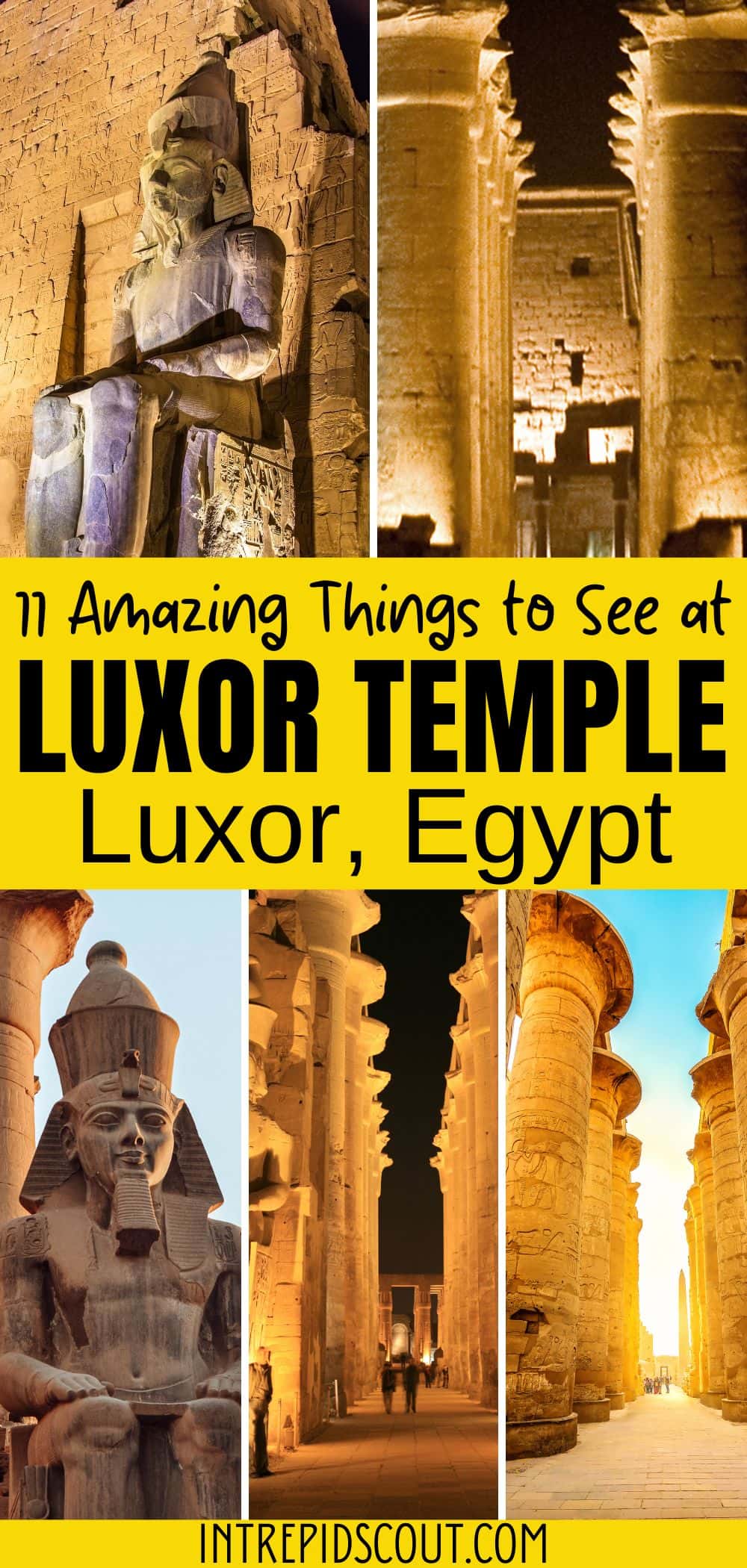
Now, It Is Your Turn, I Would Like to Hear Back from You!
Are you planning a trip to Luxor?
Please let me know! Drop me a quick comment right below!
Click on any of the images below to get inspired and to help you with the planning process for your trip to Egypt!
